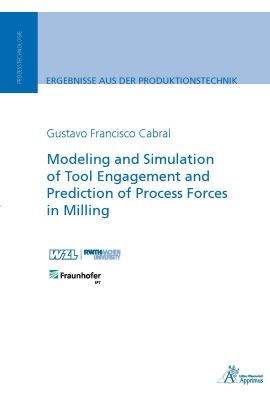Milling operations of free-form shapes with complex milling tool geometries and process strategies are among the machining processes with the highest untapped potential. Studies have shown that, in most cases, unfavorable conditions are used due to the lack of fundamental knowledge about the contact conditions between milling tool and work material. Current approaches for process design and optimization are based mostly on the macroscopic contact conditions. The microscopic contact conditions, however, are ultimately responsible for the process output. An optimization of these conditions would enable the avoidance of unfavorable contact situations and thus contribute to a significant increase in the overall process performance.
Against this background, the present work aimed the development of an advanced geometrical model for calculation of the microscopic contact conditions and prediction the process forces in multi-axis milling. In order to achieve this goal, it was necessary to investigate and to understand the factors that influence the process forces, as well as to use analytical abstractions to calculate the uncut chip geometry and derive the cutting forces.
The process was investigated with focus on finishing operations, in which the small contact conditions are even more difficult to determine, due to the higher level of complexity associated with the process. In this type of operation, the cutting edge geometry plays an important role, since the amplitude of the removed uncut chip thickness lies often in the same order of magnitude of the cutting edge radius. A model which allows the prediction of the process forces with consideration of the cutting edge geometry and process parameters was then proposed.
A geometrical model was built based on the premise that the macroscopic contact conditions are known, which is supported by current research. Based on this conditions, a universal model for calculation of the uncut chip geometry for an arbitrary tool geometry and process strategy was developed. The geometrical model was coupled to the force model and adapted to the multi-axis milling kinematics, allowing thus the prediction of the process forces in different coordinate systems.
In order to verify the proposed models, a simulation system was developed and implemented, which was used for simulating a test case that was in turn verified against experimental data.
| Autor | Cabral, Gustavo Francisco |
|---|---|
| Lieferzeit | 3-4 Tage |
| Gewicht | 0.26 kg |
| Erscheinungsdatum | 02.06.2016 |
Prozesstechnologie
Modeling and Simulation of Tool Engagement and Prediction of Process Forces in Milling
Kurzbeschreibung
This work presents an advanced model for calculation of the microscopic contact conditions and prediction of the process forces in multi-axis milling. An investigation of the factors that influence the process forces with focus on finishing operations is presented in detail. Analytical abstractions to calculate the uncut chip geometry and the cutting forces are also presented. The result is a universal model and methodology for prediction of the process forces in complex milling operations.

